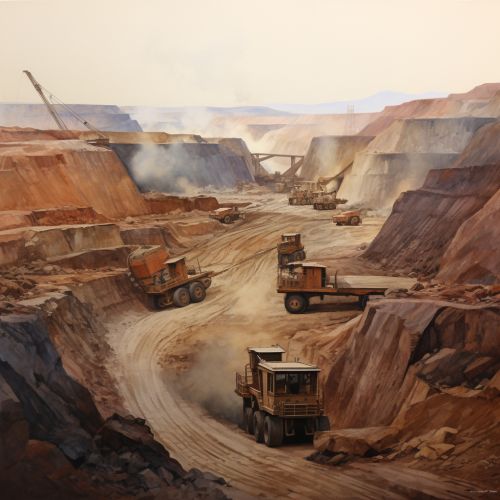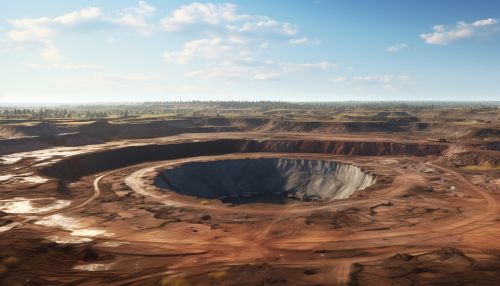Environmental impact of mining
Introduction
Mining is the process of extracting valuable minerals or other geological materials from the Earth, usually from an ore body, lode, vein, seam, reef, or placer deposit. These deposits form a mineralized package that is of economic interest to the miner. Mining has been a critical part of human civilization for thousands of years, with the earliest evidence of mining dating back to the Stone Age. While mining provides numerous economic benefits, it also has significant environmental impacts that need to be managed and mitigated.
Environmental Impacts of Mining
The environmental impacts of mining can occur at local, regional, and global scales through direct and indirect mining practices. These impacts can result in erosion, sinkholes, loss of biodiversity, or contamination of soil, groundwater, and surface water by the chemicals emitted from mining processes. These processes also emit large amounts of greenhouse gases, contributing to global warming and climate change.
Land Disturbance
One of the most visible environmental impacts of mining is the disturbance of land and soil. Mining operations often require large amounts of land to be cleared and excavated. This can result in the destruction of vegetation and habitats, and the displacement of local wildlife. In addition, the removal of soil and deep underground excavation can lead to significant changes in the landscape, including erosion, sinkholes, and instability in nearby structures.


Water Pollution
Water pollution is another major impact of mining. Mining operations often require large volumes of water to process ore or clean coal. This water, often contaminated with heavy metals, chemicals, or other pollutants, can be a significant source of water pollution if not properly managed. This can lead to the contamination of local water sources, affecting the quality of water for drinking, irrigation, and other uses. Additionally, the discharge of mine water can also affect the pH levels of local water bodies, leading to harmful effects on aquatic life.
Air Pollution
Air pollution is a significant problem in areas with heavy mining activity. Mining operations release a variety of pollutants into the atmosphere, including dust, heavy metals, and gases such as sulfur dioxide and nitrogen oxides. These pollutants can have serious health impacts on local communities, including respiratory problems, heart disease, and cancer. In addition, these gases can contribute to the formation of acid rain, which can harm vegetation and aquatic ecosystems.
Biodiversity Loss
Mining can lead to significant loss of biodiversity. As land is cleared and habitats are destroyed, local wildlife may be displaced or killed. In addition, pollution from mining operations can harm or kill plants and animals, leading to a decrease in biodiversity. This can have significant impacts on ecosystem health and function, as well as on local communities that rely on these ecosystems for food, water, and other resources.
Climate Change
Mining operations are a significant source of greenhouse gas emissions, contributing to global warming and climate change. These emissions come from the combustion of fossil fuels for power and transportation, the release of methane from coal mines, and the release of carbon dioxide during the processing of ore. In addition, the destruction of forests for mining can lead to increased carbon dioxide levels, as trees that absorb carbon dioxide are cut down.
Mitigation of Environmental Impacts
While the environmental impacts of mining are significant, there are many ways to mitigate these impacts. These include the use of cleaner technologies, the restoration of mined lands, and the implementation of sustainable mining practices.
Cleaner Technologies
The use of cleaner technologies can help to reduce the environmental impacts of mining. These technologies can reduce the amount of waste produced, decrease water and energy use, and reduce emissions of pollutants. Examples of cleaner technologies include the use of bioleaching to extract metals from ores, the use of electric vehicles in mines to reduce emissions, and the use of advanced water treatment technologies to reduce water pollution.
Land Restoration
Land restoration, or reclamation, is a key strategy for mitigating the impacts of mining on the land. This involves the restoration of the land to its pre-mining condition, or to a condition that is suitable for a new use. This can include the replanting of vegetation, the restoration of topsoil, and the creation of new habitats for wildlife. In many countries, mining companies are required by law to carry out land reclamation after mining operations have ceased.
Sustainable Mining Practices
Sustainable mining practices can help to reduce the environmental impacts of mining. These practices can include the use of renewable energy sources, the reduction of water use, and the implementation of waste management practices. In addition, sustainable mining practices can include the engagement of local communities in decision-making processes, the fair distribution of benefits from mining, and the respect for the rights of indigenous peoples and local communities.
Conclusion
While mining has significant environmental impacts, these impacts can be mitigated through the use of cleaner technologies, land restoration, and sustainable mining practices. However, more research and innovation are needed to develop and implement these solutions on a larger scale. In addition, governments, industry, and civil society must work together to ensure that mining is carried out in a way that is environmentally sustainable and socially responsible.
